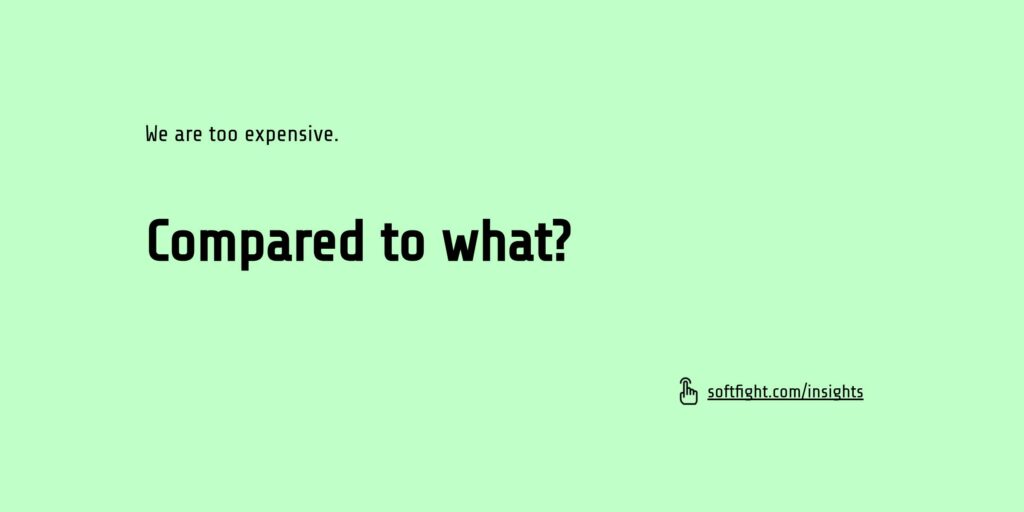You might get this reaction from customers: “your services are too expensive”.
You might realise it by looking at your proposals’ success rates, if they are lower than you want them to be. There is no guarantee that higher prices are the reason you lost the projects, but sometimes that could be the explanation.
Or you might be thinking that you are too expensive before you even show the price to your customers.
What can you do?
I have 2 versions of a possible answer:
- What you can do in 30 minutes
- What you can do in 2 weeks
30 minutes
I imagine that you just had a conversation with a potential customer, where you presented your project proposal, including price and budget.
Their reaction was something along the lines of: “we would like to work with you, but you are too expensive”. The meeting ended with them expecting to receive an updated offer from you.

What I would do and think about if I wanted to take a decision in 30 minutes:
Too expensive compared to what?
- To the alternatives?
- Do I have any information about the other options they considered? Can I verify any of it?
- What is the ratio of quality to price? Are they making a lower priced quote because the level of quality offered is lower?
- To the value for the customer?
- Have I quantified the economic value of this project’s outcomes for the customer? Do I have an estimated guess of what they stand to gain from this project and how much is that worth to them in monetary terms?
- Can I check again the calculations, to make sure they are correct in light of all the information I received from the customer?
- To their expectations?
- How were their expectations formed?
- Based on relevant past experience with similar projects?
- Or based on market data?
- With no basis in reality, just their general expectations of what this particular service should cost?
- Or based on their available budget and business case calculations?
- How were their expectations formed?
Conclusion 1.A.: “the price we quoted is the fair market value price for the quality that was promised” > in this case I see 2 options:
- Go back and explain once again why this is the correct price and why you cannot reduce it more than a “complementary discount” of 1-2%.
- Or go back with a changed offer, with a reduced level of quality and services > and a reduced price to match the change in quality.
Conclusion 1.B.: “the quality-price ratio is fair value, but they cannot pay this amount”
- If you are in a desperate situation and you really, really need this project for cashflow, then you can go back with a significantly reduced price, at the same level of quality and an explanation or excuse as to why you are willing to give them a much better offer, without looking unprofessional. The danger you need to be careful with is to not create a precedent that can come back to haunt you in the future.
- If you don’t “need” the project, but merely “want” the project, then go back and try to convince them that a higher quality outcome is in their best interest, that you can achieve that and why they should choose you.
Conclusion 1.C.: “we are more expensive than the competitors offering a similar quality” > same options as for 1.B. + a plan to re-evaluate your whole strategy.
Which leads us to the 2 weeks version.
2 weeks
- What are the business objectives for the next 6-12 months?
- Which are the customer segments that you are targeting? What problems do these customers have? How much are they willing to pay to solve those problems?
- Are there any customer segments that you have not approached until now that would be willing to pay a higher price for what you are offering?
- What are the alternatives and direct competition for these customers, for those problems?
- What level of quality are you offering? Is it competitive? Are there some attributes where you could offer better service with a small increase in cost, that can justify the higher prices you want to charge? Or maybe there are areas where you are over-delivering and incurring costs for things that customers don’t want to pay for.
- Given the market map that you have just constructed, what is the optimum pricing strategy?
- What are the pricing metrics that allow you to capture back the value you create for your customers?
- Can you do some quick market research to validate your assumptions and hypothesis?
- Run financial simulations, for different price points, that lead to different volumes of sales, that have costs, revenues and profits attached > to see which price levels get you closer to the objectives you have set in step 1.
WHAT THIS MEANS FOR YOU
Whenever the “we are too expensive” thought pops into your head, looking at strategy, customer segmentation and pricing model is always a good place to start.

